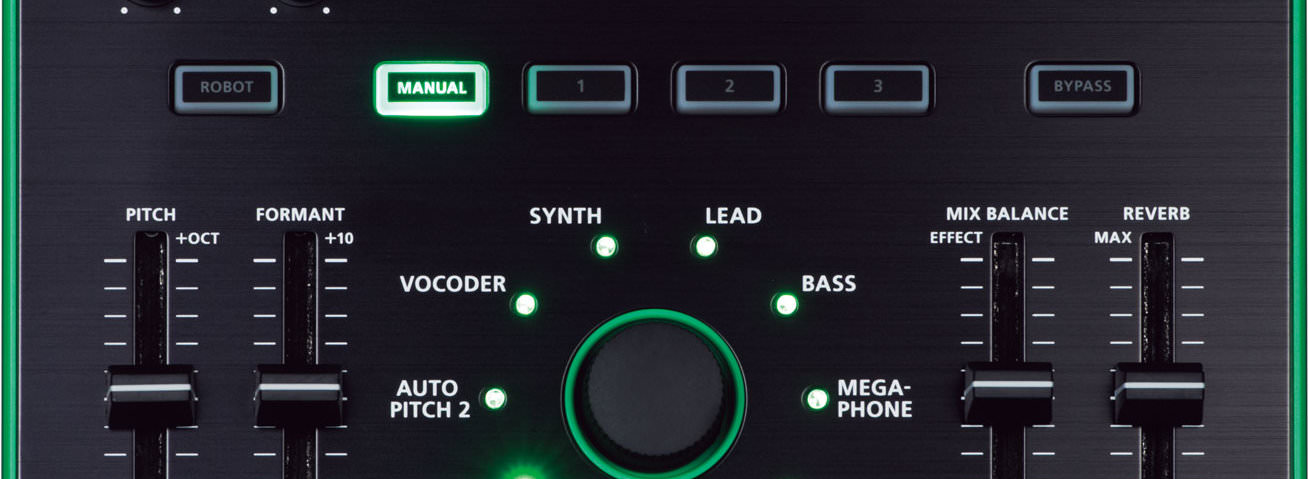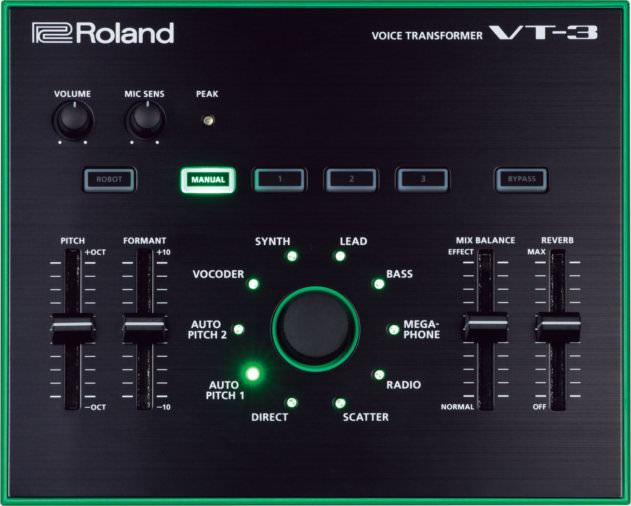The VT-3 is the surprise package of the AIRA range. Greg Scarth finds out if it might become a cult classic like the unit which inspired it.
Of the three AIRA units included in the initial product release, the VT-3 Voice Transformer attracted the least attention. Before the TB-3 and TR-8 even appeared on our radar, a leaked photo of the VT-3 revealed most of the details about this particular product but failed to generate much hype. That probably says less about the VT-3 itself than it does about the incredible demand for the TB-303 and TR-808/909 reboots, but there’s no doubt that the VT-3 is a little more of a niche product than the AIRA bass synth or drum machine.
At first glance, the inspiration for the VT-3 may not be obvious. The Boss VT-1 Voice Transformer, released in 1996, isn’t one of Roland’s most celebrated designs, but it’s become a bit of a cult favourite in recent years, partly because of its use all over The Knife’s Silent Shout. The orange and blue original is capable of a range of pitch shifting, formant shifting and vocoder-esque sounds, with a built in digital reverb for good measure
Spec
The VT-1 was an incredibly simple unit, and the VT-3 follows suit. There’s no keyboard or note programming option, no MIDI input and just a handful of main controls on the front panel. Round the back you’ll find a combo jack input for mic or instrument signals (with switchable 48V phantom power) and a pair of outputs (switchable between stereo output or wet and bypass mono signals). A foot pedal can be attached to bypass the effects, and there are 3.25mm mic and headphone connections on the front edge of the unit. Like the other AIRA products, the VT-3 also functions as a basic audio interface, hooking up over USB and sending wet and dry signals into the DAW.
The VT-1 was an incredibly simple unit, and the VT-3 follows suit.
The VT-3 is the most intuitive of the three AIRA products, which is no mean feat in this company. With a mic hooked up, talk or sing into the unit and the results are immediate and impressive. There are nine effect modes to choose from: Auto Pitch 1 and 2, Vocoder, Synth, Lead, Bass, Megaphone, Radio and Scatter. There are a couple of limitations to some modes. Whereas most traditional vocoders such as, say, Roland’s own VP-330, use separate carrier and modulator signals to create their distinctive effects, the VT-3’s vocoder effect doesn’t use a separate carrier (usually synth notes controlled via a keyboard). Likewise, the Auto Pitch modes can’t be edited, so everything’s controlled by the signal you feed into the unit. It’s not a problem so long as you’re aware that you may not always have complete control of the results.
Beyond choosing a mode, the parameters are incredibly simple. The Pitch slider has a range of an octave in each direction and works independently of the Formant control. Like the VT-1, the Reverb setting is fixed but the level can be adjusted, while the Mix Balance slider simply adjusts the wet/dry level. The Robot button instantly switches all input signals to a fixed pitch, while the Bypass button is self-explanatory. It’s incredibly basic, but it does the job perfectly well. Adjustable reverb would be nice, but it’s an understandable compromise on a unit at this price point.
Three presets can be saved to memory using the 1, 2, 3 buttons on the front panel; just hold down one of the buttons for a couple of seconds and all front panel controls are stored to memory in that slot. Tap another preset button and the associated settings are instantly recalled. The Manual button immediately switches to the setting indicated by the controls. A very simple setup but about as efficient as it gets for live performance.
The VT-3 also works surprisingly well on a much broader range of sounds than you might imagine. I tried it on individual drums, full drum and percussion loops, synths and samples. Although the results weren’t always immediately usable, with a little care to select an appropriate mode and setting, something interesting was usually achievable. Beyond the obvious uses for electro vocals and dramatic pitch shifter effects, the VT-3 has a lot of potential for twisting and mangling just about any sound you might care to throw at it.
Conclusion
The VT-3 is a lot more versatile than the cult classic VT-1. It’s not a ‘proper’ vocoder or pitch correction tool, but at this price it’s not meant to be. It’s a fun plug-and-play tool which is surprisingly effective for treating and processing a range of sounds. It’s also worth noting that at £159 it’s significantly cheaper than the VT-1, which retailed at £359 on release back in 1996. The VT-3 may not be the most obvious of Roland’s new AIRA products, but we wouldn’t be surprised if it turned into a cult classic somewhere down the line just like the unit which inspired it.
The Verdict
Price: £159
Purchase: AIRA VT-3 Voice Transformer
The Final Word
A unique processor which lends itself well to a range of sound sources.


09.57 AM
I’m a bit disappointed about VT3…..
I bought it for a live situation, but i found it soooo unreliable for that purpose…
The pitch tracking is horribly imperfect, and also reacts a bit slowly.
Without the possibility to set the scale/notes to follow, is impossible to use it for the purpose i bought it for.
The sound is GREAT, and i love each of the modes, but, without firmware upgrades about the pitch tracking, i wouldn’t reccomend this vocoder.
05.09 PM
How well does it work for robot or deep sounds? I want to get deep pitched Plastikman style vocals.
08.10 AM
can this device be connected to a mobile phone?
and can it transform the voice from male to female and vice versa? but not in a robotic way